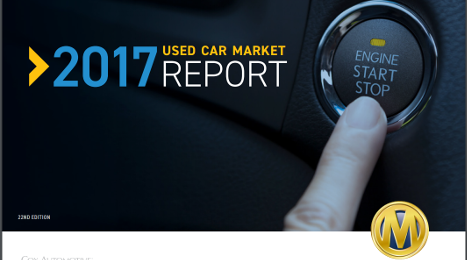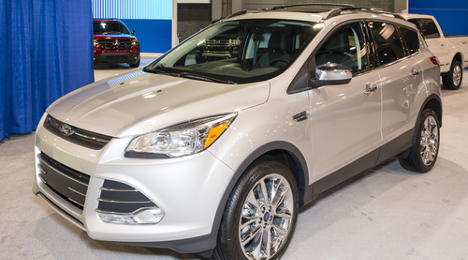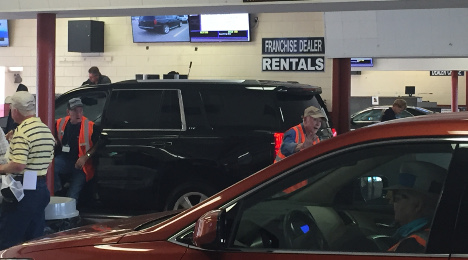Cox Automotive insisted 2016 brought good news for almost every segment of the industry. Analysts pointed out that highlights included accelerating used-vehicle sales, a record-high 17.5 million new-vehicle sales and a growing number of services and support products that are dramatically improving the efficiency of the automotive marketplace — from retail to remarketing.
These trends — and the outlook for 2017 — are explored in depth in the 22nd edition of the Manheim Used Car Market Report, presented by Cox Automotive. Each year, the compilation provides a compelling snapshot of data and trends shaping the used-vehicle business.
“2016 was most likely a bullish year for you regardless of what sector of the automotive ecosystem you’re part of,” Cox Automotive chief economist Tom Webb said in a news release.
“Looking forward, although there is looming uncertainty about the economic climate in 2017, the prospects are still good that the seven-year recovery in the automotive industry will continue,” Webb added.
A major focus of this year’s report is the speed with which new technologies and services are transforming the automotive marketplace, a fact that Janet Barnard, Cox Automotive’s president of Inventory Solutions, addressed in her introductory letter.
“We’re committed to ensuring that doing business with us becomes faster, easier and more rewarding,” Barnard said. “We are creating a seamless experience to produce efficiencies and time savings across our portfolio of brands so our clients can focus on their customers and running their businesses.”
Cox Automotive mentioned the report is designed to provide a comprehensive look at multiple segments of the automotive industry, along with a series of brief case studies and insights from key industry players. Among the highlights:
Remarketing
• NAAA-member auction sales approached 10 million in 2016.
• Wholesale prices overall have been stable over the last four years despite rising volumes.
Dealers
• New-vehicle sales were a record 17.5 million units.
• Dealers increased used-vehicle sales for a seventh straight year.
Rental
• Total rental car industry revenue reached a record $28.4 billion.
• Number of vehicles purchased by rental companies increased 4 percent to 1.82 million in 2016.
Leasing
• New retail consumer lease originations grew 7 percent in 2016 to 4.4 million units.
• Off-lease volumes will reach a record 3.6 million in 2017 and then surpass 4 million in 2018.
Repossessions
• The dollar amount of auto loans outstanding reached a record level of $1.1 trillion.
• An estimated 1.7 million vehicles were repossessed in 2016.
Fleet
• New vehicle purchases by commercial and government fleets grew 6 percent in 2016.
• Fleet management companies continued to be innovative users of data analytics and remarketing best practices to protect residual values.
International
• Global new vehicle sales for 2016 are expected to grow to 90 million units.
• China ranked first in global new-vehicle sales with 25 million units sold, a 4.6-percent increase.
The report is available for download at www.manheim.com/consulting.
Editor's note: Watch for upcoming stories published by Auto Remarketing and SubPrime Auto Finance News containing more perspective from Webb.
With vehicle shopper preference for SUVs and crossovers apparently strengthening and not waning, Cox Automotive chief economist Tom Webb is confident used-car managers should find higher amounts of those units flowing through the wholesale market this year, especially as off-lease models.
It’s all part of the wholesale surge where Webb is expecting overall wholesale volume to approach 7.8 million units by the end of next year, as more than half of that figure should be off-lease vehicles.
When asked about how the off-lease lanes might shift away from being full of less-desirable compact and midsize cars, Webb replied, “I think the worst of the imbalance is actually over where the product was relatively new in some of those crossover vehicles, which have a lot of appeal.
“They were not coming back off-lease yet, but that now has occurred,” he continued during his quarterly conference call with the media and investment analysts on Monday. “We’re now where those volumes are growing. I think that will be very helpful. It’s much more balanced than it was in the past.
“Still there are a large number of compact, basic model sedans that are being leased. But you could also argue that the consumer preference shift away from those vehicles might have already played out,” Webb went on to say.
Later in the call, Webb mentioned leasing activity increased for vehicles now in high demand, models such as Ford Escape and Toyota RAV4. Auto Remarketing went back to the State of the Automotive Finance Market Report generated by Experian Automotive that contained information from the first quarter of 2014. Turns out, Experian’s report showed that 2.91 percent of all new-model leases in the quarter were Escapes; a reading second to only the mark connected with Honda Civic at 3.45 percent.
And Experian indicated 1.97 percent of all new-model leases in Q1 2014 were for the RAV4. Meanwhile, another popular compact SUV — the Honda CR-V — also was among the top 10 leased models in that quarter as that unit generated 2.69 percent of new-vehicle leasing activity during that span.
Now, some of those units are already or soon will be going over the block.
“There are going to be a large number of compact SUV and crossover type models,” Webb said. “I think we’ll be a little more aligned with customer tastes. The overall movement in leasing the past couple of years has been toward mainstream models instead of solely focused on the luxury end of the market.”
Rental-risk unit & new-model incentive analysis
Webb indicated a straight average of auction prices in December for rental risk units sold at auction topped the $17,000 mark for the first time ever and was 5 percent higher than a year ago.
However, after adjusting rental-risk prices for broad shifts in market class and mileage, Webb determined pricing for these units softened by 4.4 percent.
Webb went on to mention the average mileage of rental-risk units sold in December (38,600 miles) was similar to recent months, but 13 percent lower than a year ago. He then reiterated why the 2015 mileage readings that surpassed 50,000 were so unusual.
“That exceptionally high mileage in 2015 was driven by some industry-specific and company-specific factors, which are gone,” Webb said. “My discussions with the rental car companies is that we’re pretty comfortable with that level to maximize value.
“There is going to be a little bit more of a tendency for a wide frequency distribution within that average mileage where there might be opportune times for the rental car companies can sell a risk unit with low mileage just because it might be hot in the wholesale market at that time,” he continued. “And there are certainly cases where they might want to extend the life, which they can with relative ease.”
And with mileage levels stabilizing, Webb also pointed out that the condition of rental risk units is perhaps as good as it’s ever been. Manheim determined the volume of units going through the wholesale market in the fourth quarter of 2016 with condition grades between 4 and 5 surpassed 40 percent to the highest level going back to Q1 of 2015.
“It was feared that as the rental car companies shifted a higher share of their sales away from auctions over to direct sales to dealers and even retail consumers that the less desirable units would end up at auction,” Webb said. “Clearly that has not been the case.
“That’s because the rental car companies also have an inherent interest in protection residual values overall. The specific brands they hold in their fleet, they know the auction represents the truest form of price discovery and as we say the only venue where you can get more than you asked for,” he went on to say.
Webb closed his off-rental discussion by insisting how much new-vehicle incentives can impact risk-unit price performance.
“With respective to incentive activity, (rental-risk units) are basically 1-year-old vehicles so they’re extremely sensitive to the incentive activity that’s going on within the new-vehicle side of the market,” he said. “We’ve been relatively but not overly aggressive. I know there are some concerns that incentive levels are at record levels, maybe adjusting them for the transaction price. But my general sense of the market is that it hasn’t destroyed the overall wholesale values at the current time. There are obviously specific segments of the market like it’s certainly hurt the compacts. There is some intense pressure to move the new units that people really don’t want to buy.
“In terms of the go forward, I’m still relatively optimistic that they don’t go crazy in terms of an incentive war,” Webb went on to say. “This cycle is a little different than previous ones where you have to realize the manufacturers themselves basically are holding the residual risk on basically about 10 million lease units that they have in their portfolio. You would think they would keep that in mind when they do their vehicle push.”
Car values are still depreciating at a faster rate than their truck values, but the gap has narrowed significantly in the past year, according to Black Book data.
From Dec. 1, 2014 to Dec. 1, 2015, car values depreciated 16.7 percent, versus 8.4 percent depreciation for trucks — a difference of more than 8 percentage points.
But in the 12 months since Dec. 1, 2015, car values have depreciated 19.1 percent, while trucks have depreciated 14.7 percent — a difference of less than 5 percentage points.
In a phone interview with Auto Remarketing last week, Black Book’s Anil Goyal attributes the slimmer gap to three things.
First, more entrants on the truck market has led to greater competition on the new-vehicle side, leading to higher incentives, which tends to downwardly impact used prices.
Next, the gap between used-truck and used-car values had climbed to an unsustainable level, he said.
Goyal — who is senior vice president of automotive valuation and analytics at Black Book — gives the example of compact crossovers and compact cars.
A year ago, the value gap between a 2- to 6-year-old compact crossover and a 2- to 6-year-old compact car was around $5,300, he said. Now the used compact crossovers are less than $5,000 more expensive than compact cars.
Subcompact crossovers are another segment where the gap has started to come down.
“If you look at a subcompact crossover one year ago versus a subcompact car, that gap was about $5,200,” he said. “And now it’s down to $4,300.”
Folks just may not be willing to shell out an additional $5,000-plus to get a subcompact crossover instead of a subcompact car.
Goyal adds, “For that demographic who’s looking to buy a smaller vehicle, that gap becomes much harder to swallow.”
The third reason? Changes in supply over the past 12 months.
“The supply was very, very, very tight a year ago on any truck segment,” Goyal said. “And that supply is starting to ease. It’s still lower than the car segments, but it’s starting to ease as more and more lease returns are coming back.”
Looking forward, will the depreciation narrow further in 2017?
Goyal said he believes it will continuing shrinking a bit.
“In the next two or three years, I don’t expect the truck depreciation to be higher than cars, because there is still going to be more and more supply coming back from the car side,” he said. “But as the new production continues to shift more towards trucks and the incentives are going to be driven from that segment, I do see the gap (continuing) to narrow a little more until there is about a 5-percentage-poitn difference.”
Some segments like full-size pickups are driving this, he said.
A 2014-model-year full-size today is retaining about 62 percent of its MSRP, Goyal said. Compare that to the three-year-old retention level (roughly 54 percent) in the overall market.
“There’s been more incentives now coming through on the pickup side” he said. So much so that Ford, Goyal pointed out, announced production and incentives cuts.
“You’re starting to see that there is more inventory and those high retention values are not sustainable,” Goyal said. “I see those retention values coming down, which will eventually cause depreciation to go up on some of those segments, which are holding up the truck depreciation so well.”
There have been 3.84 million auction sales of vehicles age 8 or younger so far this year (through Oct. 24), according to NADA Used Car Guide.
This is a 7-percent hike from the same period of 2015, and the gain for late-model volume is even stronger.
The company said in its latest Guidelines report that auction volume for cars up to 3 years old is up 10.8 percent. The highlight in that late-model class is the 2013 model-year auction volume, which has climbed 31.9 percent year-to-date due largely to off-lease supply.
On the retail side of the used-car market, Edmunds.com is calling for roughly 2.8 million used-car sales in November, which would be down from 3.1 million in October. The seasonally adjusted annualized rate for used-car sales, however, is likely to climb from 37.8 million to 37.9 million.
As far as the new-car side, Edmunds predicts that the year-to-date tally will reach 15,844,726 units by the end of this month, up ever-so-slightly from the year-ago period (15,838,458 sales)
And last year, of course, turned out to be a record year for new-car sales.
“It’s probably no coincidence that this month’s strong sales performance come at the same time that the Dow Jones Average reached an all-time high,” Edmunds executive director of industry analysis Jessica Caldwell said in a news release. “Now that the presidential election is over, shoppers have more confidence in the economy than they had just a month ago, and that gives them extra motivation to make big-ticket purchases.
“If this month’s forecast holds, December’s year-over-year sales only need to be flat to set a new annual record in 2016,” she said. “Get your popcorn ready because it’s going to be a nail-biter.”
There were 3.48 million vehicles (up to 8 years of age) sold at auction in the first three quarters of the year, according to the latest Guidelines report from NADA Used Car Guide.
That’s a 7-percent increase from 2015, and one group that has seen a particularly significant volume spike has been 2013 model-year vehicles.
NADA Used Car Guide said in the report that sales volume for these vehicles has climbed 31.4 percent year-to-date, driven largely by off-lease volume.
Late-model auction sales volume, in general, is up 11 percent, with truck and utility segments dominating the increases.
There have been 2.04 million auction sales of units up to 3 years old.
Late-model growth patterns
Looking at the late-model class in more detail, compact utility and large pickup volumes are each up 33 percent through September, with midsize utility close behind (up 32 percent).
In fact, the top eight segments for late-model volume growth are either trucks or utility vehicles.
Luxury compact utility auction sales volume has climbed 29 percent, with midsize pickups and luxury large utilities each up 27 percent. Also increasing more than 20 percent were luxury midsize utilities (up 23 percent). Meanwhile, large utility vehicle volume is up 14 percent.
Leading the car segments has been the subcompact (up 12 percent).
The segments with the largest decline in auction volume have been the large car (down 26 percent) and the luxury large car (down 25 percent).
Cox Automotive chief economist Tom Webb described September’s reading of the Manheim Used Vehicle Value Index, which represented a 1.7-percent lift year-over-year, as “not extremely unusual.”
When Webb hosted his quarterly conference call on Monday, he used a potentially troublesome adjective, “problematic,” when he touched on a figure that might push wholesale prices and the Manheim Index lower.
To recap, Manheim indicated wholesale used-vehicle prices (on a mix-, mileage-, and seasonally adjusted basis) remained unchanged between August and September, but non-seasonally adjusted prices declined 1 percent during the month. As a result, the Manheim Used Vehicle Value Index stood at 126.9 for September, an increase of 1.7 percent from a year ago.
“It’s a little bit better than I expected but not extremely better,” Webb said. “When we do the full-year numbers, I think on an annual average basis the index will show a modest increase, i.e. less than 1 percent, whereas we were expecting a decline of less than 1 percent.”
At least through the first three quarters of the year, Webb acknowledged the used-vehicle retail market “has been better than expected and that’s sort of driving it.” Webb cited data from the National Automobile Dealers Association that has used-retail sales coming in 4.5 percent higher, which “is a big change and very positive.”
And why are franchised and independent dealers turning more used metal?
“The margins have stabilized,” Webb replied.
That assessment prompted participants on Webb’s call to wonder if the retail market can continue to sop up the additional wholesale volume that’s coming, especially as off-lease activity continues to climb because of how much new-vehicle leasing is being originated by captives and other finance companies.
Webb asserted that the 3.1 million off-lease units expected to come down the lanes this year “is not that big of a deal in the grand scheme of things.” But next year’s expectation is for off-lease volume to hit 3.6 million units, which he acknowledged “is a much more problematic number.
“And then an excess of 4 million in 2018, the numbers get real big so you would expect some downward pressure (on wholesale prices),” Webb went on to say.
The Cox Automotive expert, who will be on hand for Used Car Week again this year, also mentioned that new-model leasing might be slowing down a bit from the record-setting pace seen in recent quarters. Webb shared his own estimations that new-model leasing volume is about 8 to 9 percent higher year-over-year through the first nine months of 2016. He added that he doesn’t expect a year-over-year uptick during Q4 because “we pushed out lots of leases last year.”
Webb continued, “The full-year increase is going to be significant but certainly not anything like we saw in previous years. It’s starting to level off also.
“The penetration rates start to level off because many of these lessors only have a certain amount of appetite for the amount of residual risk that they want to hold out there,” he went on to say. “I think they’re pretty well full.
“Certainly to the extent if pricing starts to deteriorate a little bit and you start showing some end-of-term losses, certainly your appetite for creating new leases is significantly less,” Webb added.
Editor’s note: Watch for upcoming reports from Auto Remarketing and SubPrime Auto Finance News for Webb’s assessment of the certified pre-owned market as well as credit availability.
A couple of years ago when pundits and naysayers wanted to discuss auto financing, often they gravitated toward how the industry’s recovery stemmed from subprime activity, resulting in a possible bubble similar to what created the Great Recession.
While analysts and experts eventually extinguished that line of thinking by showing performance data, these same industry folks could soon be refuting notions that another auto bubble is inflating — but this time because of leasing.
Earlier this month, Experian’s latest State of the Automotive Finance Market report highlighted leasing volume as a share of all new models financed set another record during the second quarter. Analysts indicated leasing continued its strong growth as the share of new vehicles leased jumped from 26.92 percent in Q2 2015 to a record high of 31.44 percent in Q2 2016.
Then this week, J.D. Power and LMC Automotive indicated that they have never seen franchised dealers slap as much cash on the hood as they are seeing this month to keep new metal turning.
Analysts reported on Monday that incentive spending thus far in September is at a record level of $3,923 per unit. That figure surpassed the previous high of $3,753 set in December 2008.
To gauge whether these trends should be triggering alarms, we visited again with Anil Goyal, senior vice president of automotive valuation and analytics at Black Book, which pushed out online survey results involving more than 500 auto finance company executives. The survey released this week showed a large number of auto finance companies say they don’t leverage residual data for their portfolio despite the majority of finance companies admitting that portfolio risk assessment and remarketing remain at the top of their portfolio strategy for a growing number of used vehicles.
“The environment we are in is more volatile with trends that are very different than what we’ve seen in the last five years, with more supply coming back, with more incentives on the new vehicle sales and leases, with increased use of leasing,” Goyal said.
“There is increased risk around residuals in both loan and lease portfolios in trying to understand what that vehicle might be worth when it’s returned or repossessed,” he continued.
Goyal recapped that projecting residual values certainly is challenging for automakers and their captives since there are “a lot of moving parts.” The OEM must coordinate production schedule, work with suppliers and forecast how much demand for a particular model there might be.
And if their projections are off, Goyal pointed out automakers can join forces with captives to incentivize their customers to take delivery. They can simply reduce the vehicle price; that's the cash on the hood. They can reduce the APR, especially since captives originate leases mostly with prime and super-prime customers.
Also, they can offer a subvented residual enhancement. For example, if the residual value projection for a vehicle is 55 percent of its worth as a new model after three years, the OEM and captive can bump up the level to 60 percent in order to make the customer’s lease payment more manageable.
“There’s a lot of those levers that the OEM and the captives have to play around with to ensure that they are making the sales on their existing vehicles and keeping their pricing competitive with others and monitoring that scenario to make the lease payment work,” Goyal said.
But off-lease vehicles are increasing in the wholesale space. Certified pre-owned sales continue to set records, but what if retail demand for those units diminishes?
“Definitely the risks in the leasing scenario are increasing. Essentially, the captive and manufacturers sometimes when they share the risk, you’re essentially pushing the losses to the back end. You’re making the sale, but you’re going to have a loss,” said Goyal, who is one of the experts coming to Used Car Week at the Red Rock Resort and Casino in Las Vegas Nov. 14-18.
“In the last few years, used-car values have been very strong, so in many cases the vehicle that got returned there was not a loss,” he continued. “In fact, in many cases there was a profit to be made because the values were higher than the residuals, especially on SUVs and trucks. But that has really propelled lease penetration.
“The forecast is lower now for where the values are going to be,” Goyal went on to say. “If more and more leases are essentially made feasible to keep that payment lower through subvented residuals, you’re now going to have a situation where the losses will start to appear on the returns.”
So does leasing bubble talk have merit? Goyal didn’t go to that degree during our conversation on Wednesday. He reiterated how leasing is primarily in the prime and super-prime credit tiers. He added rating agencies often make conservative forecasts when making their analysis of securitizations filled with leases.
“We don’t see it as a bubble, but I do think there is an increased risk developing,” Goyal told Auto Remarketing. “That essentially limits how long leasing can grow.
“If we have higher and higher incentives to make the leasing work, you’re essentially moving from selling that vehicle to really just providing the vehicle on a three-year lease and pushing out your losses as a captive and manufacturer,” he continued. “That’s a trend that could be disturbing if it continues to grow by increasing the risk in the system.”
To help mitigate that risk, Black Book’s latest white paper, “How To Grow a Profitable Used Leasing Portfolio,” can help finance companies identify which vehicles make good used leasing candidates for their portfolio. It is available for download by clicking here.
“You don’t want to have unexpected surprises,” Goyal said. “What we promote to our lenders is not a one-and-done kind of analysis. Rather it’s something that’s ongoing, a refresh of the forecast because the trends are changing.”
Through eight months of the year, there have been 3.12 million auction sales of cars up to 8 years in age, according to NADA Used Car Guide, which said this represents a 7-percent increase over the same period of 2015.
The increase in late-model auction sales (cars up to 3 years old) has been sharper: There have been 1.82 million sales, a 10-percent increase, the company said in its latest Guidelines report.
Leading the late-model crowd once again are midsize cars, with 349,000 units sold through August, and compact cars (281,000).
NADA Used Car Guide points out, however, that compact utilities, midsize utilities and large pickups are showing some nice gains.
In fact, those three lead late-model growth, with year-to-date increases of 34 percent (large pickups), 32 percent (compact utilities) and 30 percent (midsize utilities).
Auction volume for luxury compact utilities is also up 30 percent.
Auction sales volume has declined on a sequential basis in each of the last four months, but year-to-date it’s up 6 percent, according to NADA Used Car Guide.
The four-week period ending July 25 showed auction sales volume (of units up to 8 years old) down by more than 4 percent from the prior period, the company said in its latest Guidelines report.
However, with 2.66 million units sold, year-to-date volume is ahead by 6 percent.
The year-to-date increase in late-model volume (vehicles 3 years old or younger) is even more pronounced at 9 percent.
So far this year, there have been 1.55 million late-model units sold at auction, NADA UCG said. The biggest story in that crop of vehicles is the large pickup, whose late-model volume is up 33 percent.
Late-model compact utility volume has increased 30 percent, with midsize utility and luxury compact utility (both up 29 percent) not far behind. On the opposite end of the late-model spectrum, luxury large car volume is down 29 percent, with large car volume off 27 percent.
Volume slowing a good thing?
In its Blue Book Market Report released at the end of the second quarter, Kelley Blue Book reports a slowdown from the lease-return-spurred record auction volume in the first quarter.
And it might not be a bad thing.
KBB suggests this could “help stabilize values and prevent market oversaturation.”
Of course, the analysis says, auction volume is still ahead of recent years.
“However, we have not seen a faster-than-usual decline in values in the second quarter, contrary to expectations. In fact, the overall average decline in auction values in the second quarter of 2016 has matched the same pace as it did during the same period last year,” KBB said in the analysis. “This could indicate that manufacturers and rental companies are choosing to hold on to inventory, rather than oversaturate the market and risk a drop in vehicle values.”
GM Financial’s approach
To a degree, this saturation was addressed in a special presentation in June by GM Financial chief financial officer Chris Choate.
He emphasized that GM Financial and the parent automaker have plans in place not only to handle off-lease volume but also establish residual values that do not place undue risk on the finance company.
“GM’s actions to predict residual values include, and this has been much discussed over the last several months and quarters, the managing of fleet sales, actively managing new vehicle inventory and maintaining disciplined incentive spending. All of those have a downstream impact on residual values that GMF has to wrestle with as vehicles come off-lease,” Choate said during his prepared presentation.
“GMF has developed a robust end-of-term remarketing process,” he continued, referencing endeavors such as its private label online wholesale marketplace at GMFDealerSource.com. “It’s designed to support the GM dealer base while also maximizing resale values.
“The more vehicles that we can dispose higher up the food chain to GM dealers either at a local, regional or even national level, keeps those vehicles out of the wholesale auction markets where they will bring less value and, therefore, have a detrimental effect on residual value.”
Staff Writer Nick Zulovich contributed to this report.
If dealers aren’t already looking through the rental-risk unit run sheet at the auctions where they typically buy inventory, perhaps they should be — considering what might be crossing the block nowadays.
“It’s interesting as we note the typical rental-risk unit comprises a much more diverse mix of models, makes and colors than there used to be in the past. That’s good,” Cox Automotive chief economist Tom Webb said. “There are a lot of different options for a dealer when looking at the off-rental units. They can probably buy something that their customer wants.
“The rental fleet is much more diverse. Certainly, it’s skewed to the car side, but a lot of small crossovers because the rental car companies are doing a good job of remarketing them. You’ve got those specialty high-line rental units now, which is also a good thing,” Webb continued.
“Even with the models, the rental car companies do a much better job of contenting the vehicle like a traditional retail unit as opposed to in the past where you could say ‘that’s a rental unit’ because it’s got crank windows or something. Those days are past. There used to be a time where all those were painted white, which was not good either for residual values. It’s a much nicer spectrum of vehicles,” he went on to say.
A year ago when Auto Remarketing compiled its annual report about the off-rental market, Manheim noticed mileage for these units at an all-time high. A streak of four consecutive quarters for mileage increases left the average well above 50,000 miles, more than double the figure Manheim spotted in early 2007.
“The average mileage now is more in tune with what we’ve seen since this recovery started,” said Webb, who put the average at the midpoint of this year at about 38,500 miles. “It’s more like the 2009 through 2014 time period.
“A lot of that was caused by Hertz, primarily the second quarter of 2015, where it hit record highs. They were going through a lot of management changes and they had issues with SEC filings so they just kept their units longer,” Webb added.
Over at KAR Auction Services, executive vice president and chief economist of ADESA Analytical Services Tom Kontos isn’t seeing as much of an average mileage drop-off. Kontos indicated the average mileage for rental-risk units going down the lanes at ADESA is still near 50,000.
“That’s the data I get from our auctions. Maybe more broadly, the trend isn’t quite so high. But at least the units we’re selling at ADESA, we’re seeing pretty high mileage,” Kontos said.
Still, Kontos agreed that off-rental vehicles are a hit with dealers, especially if they can obtain highly coveted program units during closed factory sales.
“The consistency of those (program) vehicles is what it’s always been,” Kontos said. “If they’re not already in good condition, the manufacturers do what they can to recondition them. Those units are always some of the better cars available to dealers at auction.
“The demand and attractiveness of off-rental vehicles is probably better than it already was because it was already pretty good,” Kontos continued. “The rental-risk units have been attractive to franchise dealers because they’re in the younger age category — a current or 1-year-old model.
“What I would add that’s different today is the popularity of certified pre-owned vehicles, where the off-rental unit does lend itself to very well,” he went on to say.
ABC St. Louis general manager Todd Ritter concurred with Kontos’ assertion about the connection of CPO and off-rental vehicles bringing out the hammer at his auction each week.
“I think dealers have always used rentals to fill spots on their lots. With the growth of CPO, we definitely have seen an increase in demand for these vehicles,” Ritter said.
Rising off-rental supply
Both Webb and Kontos pointed out supply of off-rental units in the wholesale market is on the rise simply because rental car company fleets are growing.
“Since the recession ended, new vehicles into the rental fleets have gone up,” Kontos said. “Now it’s not been disproportionate to the growth in new-vehicle sales in general, so it’s not as if manufacturers have been favoring rental sales to the degree they might have before the recession.
“The fact of the matter is there has been growth of new vehicles into the rental fleet, and therefore you would expect growth — and there has been — in off-rental volume over the last few years at auction,” he continued.
And like Webb mentioned, the diversity of rental-risk volume has expanded. No longer are the rental lanes full of domestic, four-door sedans painted white with not many features beyond an engine and transmission.
“The actual volumes are spread across a wider array of manufacturers than there used to be in the past where it was traditionally GM, Ford and Chrysler. Actually GM, Ford and Chrysler’s share of sales into rental is now less than it’s ever been,” Webb said.
“The sales into rental are actually front-loaded into the first part of the year so we’re up about 6.7 percent year-to-date through July,” he continued.
“The interesting thing this year that has gotten a lot of press is General Motors has pulled back very dramatically from new-vehicle sales into rental this year whereas some players have increased,” Webb went on to say.
And while GM might be delivering fewer units to rental companies, what the automaker is doing in the remarketing department is disciplined, too. ABC St. Louis runs hundreds of GM units down its lanes each week.
“Our major rental account (GM) has a standard risk turn-in policy, so they have stayed fairly consistent,” Ritter said.












